| Pages:
1
..
17
18
19
20
21
..
25 |
physics inclination
Harmless

Posts: 40
Registered: 24-6-2017
Location: the field of physics
Member Is Offline
Mood: thermodynamically stable
|
|
Ok I know this is really tangential post, but copper nitrotetrazolate has possibly the best acronym for an explosive Ive seen so far, maybe barium
nitrotetrazolate could compete with it though (BaNTZ i.e. of the dank persuasion) 
|
|
|
Dornier 335A
Hazard to Others
  
Posts: 231
Registered: 10-5-2013
Location: Northern Europe
Member Is Offline
Mood: No Mood
|
|
NeonPulse, when you write CuNTZ, do you mean Cu(NTZ)2 or Cu(NTZ)2*NTZ? The second being the intermediate in NaNTZ synthesis.
I synthesised DBX-1 with really good yield a few months back but didn't have time to record a video. It's a really nice primary in every way though so
I really should do some tests with it. I also have a small sample of pure 5-nitrotetrazole drying over concentrated sulfuric acid. It was made by
extracting an acidified solution of NaNTZ with diethyl ether.
|
|
|
nitro-genes
International Hazard
    
Posts: 1048
Registered: 5-4-2005
Member Is Offline
|
|
Made an inquiry at Gaylord chemical, said I was looking for CuNTZ, but just got an angry reply back. 
Do you guys know how stable 5-ATZ is on prolonged storage? An MSDS I found mentioned that it should be kept in an airtight container? Also said it has
a distinct smell ( I smell nothing), does it react with oxygen/moisture/sublimate or something? Dangerous?
[Edited on 3-8-2017 by nitro-genes]
|
|
|
JJay
International Hazard
    
Posts: 3440
Registered: 15-10-2015
Member Is Offline
|
|
I'm pretty sure their major product is DMSO... probably not a good place to source CuNTZ....
|
|
|
NeonPulse
Hazard to Others
  
Posts: 417
Registered: 29-6-2013
Location: The other end of the internet.
Member Is Offline
Mood: Isolated from Reality! For Real this time....
|
|
Quote: Originally posted by Dornier 335A  | NeonPulse, when you write CuNTZ, do you mean Cu(NTZ)2 or Cu(NTZ)2*NTZ? The second being the intermediate in NaNTZ synthesis.
I synthesised DBX-1 with really good yield a few months back but didn't have time to record a video. It's a really nice primary in every way though so
I really should do some tests with it. I also have a small sample of pure 5-nitrotetrazole drying over concentrated sulfuric acid. It was made by
extracting an acidified solution of NaNTZ with diethyl ether. |
It was the second one which I did need for the Na NTZ. When I first saw the acronym for the copper II NTZ I got a laugh out of that too. I did a
little experimenting with recrystallising some and found the colour changed dramatically to a sky blue with a majority of the green being insoluble
and removed by filtration. The junk left in the filter was Kahki green and when I attempted to light it up it was not very explosive and kind of
crackled with green flames. The resulting filtrate was allowed to cool slowly in an attempt to grow crystals but they were tiny and there seemed to be
an avalanche precipitation. The product was also much more flame sensitive than before. I wondered why Engager never mentioned this in his
publication.
A sample of pure 5-NTZ would be great to have. I wanted to attempt it in the future- once I get enough of the sodium salt to experiment with. These
compounds take quite some work to make as you know. It's extreme sensitivity and being very hygroscopic is a bother though. I don't want a repeat of
the incident I had when trying to make the ditetrazoylhexazadiene. That shook me up good. I still haven't attempted to make it again since that. One
day I am going to make it though. I'm fairly sure what went wrong for me there.
As for the 5-Aminotetrazole having a smell, I have not noticed any odour at all in my samples made from both methods. In solution they have a distinct
smell though. As far as I know It is quite stable in storage under ambient conditions and slightly elevated temperatures too. I keep mine in an amber
jar airtight in a normal temp range 15-30c.
[Edited on 7-8-2017 by NeonPulse]
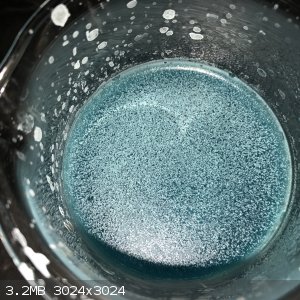 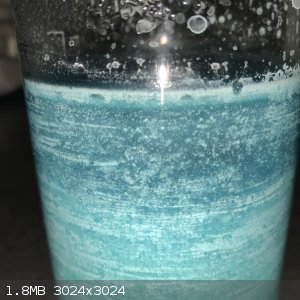
|
|
|
Dornier 335A
Hazard to Others
  
Posts: 231
Registered: 10-5-2013
Location: Northern Europe
Member Is Offline
Mood: No Mood
|
|
You hydrolyse the copper acid salt during your recrystallisation! You end up with the pale blue Cu(NTZ)2 and 5-NTZ solution.
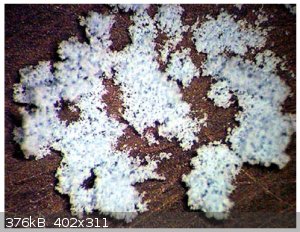
The picture is from Primary Explosives by Robert Matyas. There's more information about the salt on pages 201-203 but it's not as good as
lead azide and not a very interesting primary.
|
|
|
PHILOU Zrealone
International Hazard
    
Posts: 2893
Registered: 20-5-2002
Location: Brussel
Member Is Offline
Mood: Bis-diazo-dinitro-hydroquinonic
|
|
Quote: Originally posted by Dornier 335A  | You hydrolyse the copper acid salt during your recrystallisation! You end up with the pale blue Cu(NTZ)2 and 5-NTZ solution.
The picture is from Primary Explosives by Robert Matyas. There's more information about the salt on pages 201-203 but it's not as good as
lead azide and not a very interesting primary.
|
I wonder how is it possible to have a copper acid salt with NTZ (nitrotetrazole) what has only one proton?...
Usually acidic salts are possible with diprotic or multiprotic acids...typical example would be H2SO4
==> Na2SO4 (neutral)
==> NaHSO4 (acidic)
It is more complex with some metallic salts that can hydrolyse if too diluted
CuSO4 would be a neutral salt
Cu(HSO4)2 would be an acidic salt
Cu2(OH)2SO4 would be a basic salt
In the case of NTZ...
Cu(NTZ)2 would be neutral
Cu(OH)NTZ would be basic...
I suspect you meant this last one (the basic salt)...because
Cu(NTZ)2 + H2O <====> Cu(OH)NTZ + H-NTZ
The basic salt will indeed be less energetic because the proportion of metallic dead weight % by weight is higher into this than into the neutral salt
(what contains more explosive counterpart).
Maybe there was a confusion with tetrazole (and not nitrotetrazole)?
==> Tetrazole contains 2 H that may display acidic properties and what is thus a diprotic acid...but that express only into strongly basic
conditions...
PH Z (PHILOU Zrealone)
"Physic is all what never works; Chemistry is all what stinks and explodes!"-"Life that deadly disease, sexually transmitted."(W.Allen)
|
|
|
nitro-genes
International Hazard
    
Posts: 1048
Registered: 5-4-2005
Member Is Offline
|
|
Probably all very dangerous and stupid ideas ...but...
Could you perform VNS using hydroxylamine on 5-ATZ or 5-NTZ?
Could 5-hydrazotetrazole react with nitrite under almost neutral conditions to form a pentazadiene bridge or would only 5-azidotetrazole be produced?
What would be the products if diamino tetrazole would couple with a solution of 5-diazotetrazole? Same for di/triaminoguanidine?
Same if 5-nitraminotetrazole or the dinitramine would be reduced with hydrazine?
Would it theoretically be possible to attach a tetrazine-N,N-1,3 dioxide ring to a tetrazole ring, analogous to the already synthesized TTTO? (8
nitrogens in row, so probably not)
[Edited on 8-8-2017 by nitro-genes]
|
|
|
Dornier 335A
Hazard to Others
  
Posts: 231
Registered: 10-5-2013
Location: Northern Europe
Member Is Offline
Mood: No Mood
|
|
No Philou, "copper acid salt" is just an old name for the intermediate in nitrotetrazole synthesis, Cu(NTZ)2*HNTZ *(H2O)4. It's a pretty accepted term
though. So you can see how this could decompose into Cu(NTZ)2 and 5-NTZ. The dibasic salt (Cu(NTZ)2*2Cu(OH)2) exists too but it lacks the properties
of a primary.
|
|
|
PHILOU Zrealone
International Hazard
    
Posts: 2893
Registered: 20-5-2002
Location: Brussel
Member Is Offline
Mood: Bis-diazo-dinitro-hydroquinonic
|
|
Quote: Originally posted by Dornier 335A  | | No Philou, "copper acid salt" is just an old name for the intermediate in nitrotetrazole synthesis, Cu(NTZ)2*HNTZ *(H2O)4. It's a pretty accepted term
though. So you can see how this could decompose into Cu(NTZ)2 and 5-NTZ. The dibasic salt (Cu(NTZ)2*2Cu(OH)2) exists too but it lacks the properties
of a primary. |
Thank you for the infos and explanations :-).
[Edited on 8-8-2017 by PHILOU Zrealone]
PH Z (PHILOU Zrealone)
"Physic is all what never works; Chemistry is all what stinks and explodes!"-"Life that deadly disease, sexually transmitted."(W.Allen)
|
|
|
NeonPulse
Hazard to Others
  
Posts: 417
Registered: 29-6-2013
Location: The other end of the internet.
Member Is Offline
Mood: Isolated from Reality! For Real this time....
|
|
Despite hydrolysis of my product I still got nice yield of NaNTZ crystals upon reacting the copper NTZ with NaOH reducing the solutions volume and
cooling. Maybe a little lowered yield but 10-15g. Certainly Enough to experiment further.
|
|
|
nitro-genes
International Hazard
    
Posts: 1048
Registered: 5-4-2005
Member Is Offline
|
|
Could only find some info on the diammonium, sodium, potassium and silver salt of 5-nitraminotetrazole, so I decided to make about 100 mg's of a
copper(II) salt of NATZ by reaction of diammonium 5-nitraminotetrazolate and copper(II) sulfate, which precipitates a light green amorphous
precipitate. Not sure if this would be Cu(II)(NATZ) or Cu(II)(NATZ)2, probably the former. It only crackles when touched by flame, but when heated
over a flame it first turns brownish/black then detonates with great brisance at around 300 deg C. Also tried to make the Cu(I) salt by reduction with
ascorbic, but just got some mustard yellow coloured gel-like crud that wouldn't filter, perhaps the Cu(I) salt is too soluble or too fine a
precipitate.
It seems Cu(II)(NATZ) doesn't need too much to make DDT, has a Cu(II)(NATZ)(NTZ) complex ever been made? The nickel(II) salt of 5-nitraminotetrazole
also seems very soluble, still would like to try if NATZ may form some more water insoluble and more flame sensitive complexes with nickel(II) nitrate
and hydrazine. Are any of these already known?
[Edited on 9-8-2017 by nitro-genes]
Attachment: 200 ug of Cu(II)(NATZ).avi (3.6MB)
This file has been downloaded 921 times
|
|
|
NeonPulse
Hazard to Others
  
Posts: 417
Registered: 29-6-2013
Location: The other end of the internet.
Member Is Offline
Mood: Isolated from Reality! For Real this time....
|
|
DBX-1
after thinking about my first attempt and failure of synthesizing DBX-1 last year i realized my problem was mostly due to the poor quality of copper I
chloride i had used. it was old and there was far too much copper II present for it to work n this intended use.
So I made a fresh batch CuCl by reducing a fresh batch of CuCl2 with Na2SO3 and keeping it un exposed to oxygen as possible before use. satisfied with
the result i set about making DBX-1 by using the preparation outlined in example 2 of the US patent No:2013/204005A1
0.9g CuCl was put into a 100ml RBf with a small oval stir bar added and 20ml distilled water was also added to suspend the CuCl. next a solution of
2.08g of NaNTZ in 30ml Dist H2O was added to the flask all at once. the resulting solution was at first an olive colour which quickly changed to light
brown and then to orange upon heating being applied.
the flask was fitted with a reflux condenser with cold water running and heating was applied to the flask to bring the temp up to a steady reflux.
i had a worry about the contents being very thick and not stirring properly so i added more H2O to help it stir.
this was kept up for just short of an hour and heating was removed.
the result was a rust coloured precipitate in a fairly clear solution which was filtered on a buchner funnel, rinsed with portions of water and
finally with Anhydrous IPA and left to dry overnight. the weight of my yield was exactly the same as the patent example- 1.12g.
upon testing my product i was surprised to find that when lit it flashed off very fast similar to mercury fulminate. i was expecting a sharp snap and
torn foil like with it's silver counterpart. when heated from below though the story was different.
it's brisance was clear. it is a high performer.
with some impact testing it did not seem overly sensitive when hit between steel surfaces, taking a light blow to fire it - this changed to a minimal
tap when hit on concrete though. same with a friction test- it barely crackled on steel when rubbed hard with a ball hammer but on concrete it went
off with just dragging the weight of the hammer itself over the sample.
for some final testing though i plan to test a tiny amount of DBX-1 on top of well pressed 200mg samples of TNT,PETN,ETN and MHN.
quite happy with this stuff so far though.
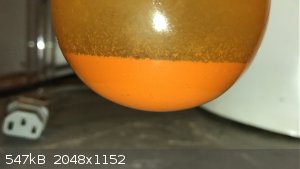 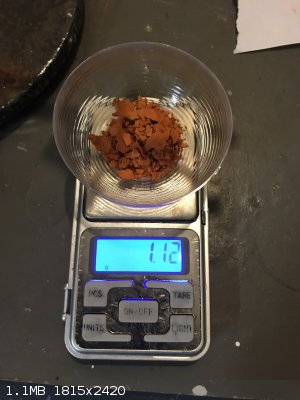
|
|
|
Laboratory of Liptakov
International Hazard
    
Posts: 1386
Registered: 2-9-2014
Location: Technion Haifa
Member Is Offline
Mood: old jew
|
|
DBX 1 is very sofistics energetic material. I am curious on compare testing with ETN...The Hat down....thanks for description. Dr.....:-)
Password of the day: Is there Copper? So it hit ... ...Dr. ...Dr.
Development of primarily - secondary substances CHP (2015) Lithex (2022) Brightelite (2023) Nitrocelite and KC primer (2024)
|
|
|
greenlight
National Hazard
   
Posts: 737
Registered: 3-11-2014
Member Is Offline
Mood: Energetic
|
|
Nice work NP!
I don't have any experience with tetrazoles but I know DBX 1 is going being looked at as the main replacement for lead azide being with it being non
toxic and not heavy metal salt.
It seems that green explosives is the way for the future commercial research.
I look forward to seeing how it performs with initiation of secondaries.
[Edited on 26-8-2017 by greenlight]
Be good, otherwise be good at it 
|
|
|
PHILOU Zrealone
International Hazard
    
Posts: 2893
Registered: 20-5-2002
Location: Brussel
Member Is Offline
Mood: Bis-diazo-dinitro-hydroquinonic
|
|
Quote: Originally posted by greenlight  | Nice work NP!
I don't have any experience with tetrazoles but I know DBX 1 is going being looked at as the main replacement for lead azide being with it being non
toxic and not heavy metal salt.
It seems that green explosives is the way for the future commercial research.
I look forward to seeing how it performs with initiation of secondaries.
|
Paradoxally when analysing soil for heavy metals (at least here into Europe)...
==> Copper (Cu) is into the list of the dozen of requested metal quantification...
==> Green explosive maybe refer to the color     and not to the enviro-friendlyness and not to the enviro-friendlyness 
Better switch to Na, K, Ca, Fe, Mg, Al, ... NH4, N2H5, guanidinium, ...
[Edited on 27-8-2017 by PHILOU Zrealone]
PH Z (PHILOU Zrealone)
"Physic is all what never works; Chemistry is all what stinks and explodes!"-"Life that deadly disease, sexually transmitted."(W.Allen)
|
|
|
nitro-genes
International Hazard
    
Posts: 1048
Registered: 5-4-2005
Member Is Offline
|
|
Very nice! How sensitive is DBX-1 to flame or a glowing splint? Do the properties change upon storage? IIRC DBX-1 was sensitive to moisture upon
storage, does DBX-1 itself also slowly oxidize to Cu(II) in contact with air?
After some reading... ( ) solutions of Cu(II) and salts of NATZ form Cu(NATZ)2,
which is a hydrate and unsuitable as a primary. It seems water of hydration is the main problem with salts of NATZ, while its difficultly obtained
anhydrous salts (such as the calcium salt ) seem more useful and even been suggested as a lead azide replacement. Tried to make a putative
Ni(II)(hydrazine)2(NATZ) salt to see if this would increase flame sensitivity. Its a lilac in colour (like NHN) but similarly insensitive to flame as
the copper salt, and even more reluctant to make DDT upon heating. Wonder if potential double salts/complexes of 5-NATZ and styphnates or
trinitrophloroglucinates would exist and be more interesting. Since most of these form hydrates itself, probably not, but who knows? ) solutions of Cu(II) and salts of NATZ form Cu(NATZ)2,
which is a hydrate and unsuitable as a primary. It seems water of hydration is the main problem with salts of NATZ, while its difficultly obtained
anhydrous salts (such as the calcium salt ) seem more useful and even been suggested as a lead azide replacement. Tried to make a putative
Ni(II)(hydrazine)2(NATZ) salt to see if this would increase flame sensitivity. Its a lilac in colour (like NHN) but similarly insensitive to flame as
the copper salt, and even more reluctant to make DDT upon heating. Wonder if potential double salts/complexes of 5-NATZ and styphnates or
trinitrophloroglucinates would exist and be more interesting. Since most of these form hydrates itself, probably not, but who knows?
[Edited on 28-8-2017 by nitro-genes]
|
|
|
NeonPulse
Hazard to Others
  
Posts: 417
Registered: 29-6-2013
Location: The other end of the internet.
Member Is Offline
Mood: Isolated from Reality! For Real this time....
|
|
Quote: Originally posted by nitro-genes  | Not sure how easily other some other triazoles would form when acetic acid/acetate is present during the heating step. From what I've read,
acylhydrazides need higher temperatures and anhydrous conditions to form (STUDIES OK THE FORMATION OF 4-AMINOTRIAZOLE DERIVATIVES FROM ACYL
HYDRAZIDES, ROBERT M. HERBST AND JAMES A. GARRISON).
I've seen the cyanamide fertilizer bags for sale, just more fun going all the way from urea though.  Cyanamide was homemade by pyrolysis of calcium cyanurate at 800-1000 deg C. Used a welded 150mm diameter stainless
steel container with 5 cm of 20 mm stainless tubing protruding from one end by which it could be filled and emptied. A conically shaped stainless
steel weight was placed on top of the 20 mm tubing so that when fired, gasses could escape by lifting the weight up, closing it again when no more gas
is produced. Worked nicely and gave abundant amounts of silvercyanamide on testing (can this be used for quantification of purity?). Yield was 90% of
theory from calcium cyanurate and got 360 grams calcium cyanamide in total from 2 firings, which is more than I need anyway. The original goal was to
make dicyandiamide, but decided a small amount of 5-ATZ would also be nice.[/ Cyanamide was homemade by pyrolysis of calcium cyanurate at 800-1000 deg C. Used a welded 150mm diameter stainless
steel container with 5 cm of 20 mm stainless tubing protruding from one end by which it could be filled and emptied. A conically shaped stainless
steel weight was placed on top of the 20 mm tubing so that when fired, gasses could escape by lifting the weight up, closing it again when no more gas
is produced. Worked nicely and gave abundant amounts of silvercyanamide on testing (can this be used for quantification of purity?). Yield was 90% of
theory from calcium cyanurate and got 360 grams calcium cyanamide in total from 2 firings, which is more than I need anyway. The original goal was to
make dicyandiamide, but decided a small amount of 5-ATZ would also be nice.[/
I Managed to find that reference where Engager tested his product for purity using this method: from his post in the prepublications:'ve managed to
preform quantitative analysis of product produced as described above. 1g of product was added to 150 ml of cold water and stirred for several minute,
2-3 ml of 70% HNO3 is added and mixture is stirred until all solid is dissolved and transparent solution is obtained. After this solution is
complemented with 4 ml of 25% ammonia, and solution of 4.5g of silver nitrate in 50 ml of water with stirring. On addition of ~40 ml more of 25%
ammonia silver cyanamide is precipitated as pale yellow mircrocrystalline solid. Mixture is stirred for 10 minutes, precipitate is filtered off,
washed with water and alcohol and dried. Silver cyanamide is weighted and checked against theoretical of 3,197g for 100% calcium cyanamide. Analysis
for my sample shown that is gives 2.85g of silver precipitate, indicating that sample contained 89.15% of pure calcium cyanamide, corresponding to
nitrogen content of 31.2% (vs 34% calculated for formula CaNCN)
Also in reference to the DBX-1 I had made recently,?i tested its sensitivity to an ember on a splint and it is very easy to set it off this way. Flame
is the same. Holding the flame just away from the sample also sets it off but with a slight delay. It has the characteristic whump of mercury
fulminate or DDNP leaving a small patch of copper metal as a residual coating on the surface it was on before igniting. I'm just waiting for my new
.001 scales to accurately measure amounts I'm working with. It is pretty snappy and I could easily see a small amount doing nasty damage if an
unwanted detonation did occur so using small amounts Is a wise choice. I should have results of further tests in the next week or so, once I get rid
of this rootkit on my PC which is consuming what little time I have spare lately. Darn computers. I'd have thrown it out the window if it didn't cost
so much.
|
|
|
|
nitro-genes
International Hazard
    
Posts: 1048
Registered: 5-4-2005
Member Is Offline
|
|
Sounds like DBX-1 is even more flame sensitive as lead azide and pretty friction sensitive as well, crystal shape probably being an important factor.
Considering the reaction is a pyrolysis at ~1000 deg C, a product of 90% purity in 90% yield is still amazing.  Dilute solutions of calcium cyanamide in cold water and precipitating the silvercyanamide as a more course
crystalline solid would help. Due to it's very low solubility it seems to form a really fine precipitate, easily partially escaping the filter. Been
wondering if you could precipitate silvercyanamide as an extremely fine precipitate in very dilute solutions, maybe light extinction of the suspension
could also be measured somehow. Dilute solutions of calcium cyanamide in cold water and precipitating the silvercyanamide as a more course
crystalline solid would help. Due to it's very low solubility it seems to form a really fine precipitate, easily partially escaping the filter. Been
wondering if you could precipitate silvercyanamide as an extremely fine precipitate in very dilute solutions, maybe light extinction of the suspension
could also be measured somehow.
|
|
|
PHILOU Zrealone
International Hazard
    
Posts: 2893
Registered: 20-5-2002
Location: Brussel
Member Is Offline
Mood: Bis-diazo-dinitro-hydroquinonic
|
|
Quote: Originally posted by nitro-genes  | Sounds like DBX-1 is even more flame sensitive as lead azide and pretty friction sensitive as well, crystal shape probably being an important factor.
Considering the reaction is a pyrolysis at ~1000 deg C, a product of 90% purity in 90% yield is still amazing.  Dilute solutions of calcium cyanamide in cold water and precipitating the silvercyanamide as a more course
crystalline solid would help. Due to it's very low solubility it seems to form a really fine precipitate, easily partially escaping the filter. Been
wondering if you could precipitate silvercyanamide as an extremely fine precipitate in very dilute solutions, maybe light extinction of the suspension
could also be measured somehow. Dilute solutions of calcium cyanamide in cold water and precipitating the silvercyanamide as a more course
crystalline solid would help. Due to it's very low solubility it seems to form a really fine precipitate, easily partially escaping the filter. Been
wondering if you could precipitate silvercyanamide as an extremely fine precipitate in very dilute solutions, maybe light extinction of the suspension
could also be measured somehow. |
Did you test the same procedure onto the "unburned" original product of Ca cyanurate?
This to exclude the fact the precipitate could be Ag2SO4, AgCl, Ag2CO3 or Ag2O/AgOH.
If it is just a precipitation reaction between cyanamide and Ag(+)... why did you add HNO3 and NH4OH?
==> The NH4OH may react with the Ag(+) by compexing (solubilising) it or by forming a precipitate of AgOH/Ag2O
==> The HNO3 may reduce the precipitation of Ag cyanamide
PH Z (PHILOU Zrealone)
"Physic is all what never works; Chemistry is all what stinks and explodes!"-"Life that deadly disease, sexually transmitted."(W.Allen)
|
|
|
nitro-genes
International Hazard
    
Posts: 1048
Registered: 5-4-2005
Member Is Offline
|
|
This might be something to test indeed, whether silver cyanurate is soluble in ammonia, although any possible cyanuric acid should mostly precipitate
upon acidification of the calcium cyanamide (when not too dilute solutions are made that is, solubility is 0.3g/100ml at 25 deg C) and result in a
cloudy solution of cyanamide. (Didn't notice this during my simple add-calciumcyanamide-to-cold-HCl-test) Some like dicyandiamide, guanidine, cyanides
and cyanates may also form insoluble silver complexes/salts. Don't know their solubility, but if less soluble than the generally very soluble Ag-NH3
complexes of most simple anions, these could precipitate as well, along side the silver cyanamide. The latter two could interfere even though the
calcium cyanamide solution is acidified, some HCN,HOCN and CO2 may still be present in the cold acidified and dilute cyanamide solution. Not sue about
the solubility of silver carbonate in ammonia, supposedly it is a yellow salt was well, similar to silver cyanamide.
It's still a reasonable approximation probably, but due to the very fine precipitate of silver cyanamide, side reactions of calcium cyanamide when
added to water and upon acidification (to free all cyanamide from the nearly insoluble calcium salts), possible precipitation of other silver
complexes/salts and without a reagent grade calcium cyanamide as a positive control, it seems more of an expensive rough indication than accurate
quantitative test.
[Edited on 4-9-2017 by nitro-genes]
|
|
|
Rosco Bodine
Banned
Posts: 6370
Registered: 29-9-2004
Member Is Offline
Mood: analytical
|
|
Simplified method for NaNT
US9598380
Attachment: US9598380 Facile method for preparation of 5-nitrotetrazolates using a batch system.pdf (614kB)
This file has been downloaded 988 times
|
|
|
Tdep
National Hazard
   
Posts: 519
Registered: 31-1-2013
Location: Laser broken since Feb 2020 lol
Member Is Offline
Mood: PhD is done! It isn't good but it's over lol
|
|
That's a great find Rosco, seems like a large improvement over the current method for both industry and amateur, if it does indeed work as described.
Improvements to the speed of the synthesis as well as the safety, seems great.
|
|
|
Dornier 335A
Hazard to Others
  
Posts: 231
Registered: 10-5-2013
Location: Northern Europe
Member Is Offline
Mood: No Mood
|
|
That is fantastic! Twice the yield, quick and safe process and everything in a single step. This used to be the bottleneck in nitrotetrazole
production so I think we'll see more of that ion in the future!
|
|
|
Rosco Bodine
Banned
Posts: 6370
Registered: 29-9-2004
Member Is Offline
Mood: analytical
|
|
For these type of slow additions, rather than making the addition "dropwise" from an addition funnel, it is a more precise method to use a very low
flow rate metering pump like a syringe pump or similar low flow pump to slowly inject the reactant solution through a capillary or a small gauge
cannula with the discharge below the surface in the stirred reaction mixture.
The injected reactant is sheared away as a continuous mix injected in the current of the liquid swirling past the injection point, so there is no
cyclical impulse for the reaction waiting for each drop to grow and fall by gravity as an addition in much larger droplet sized increments. Infusion
by precision method would be completely controllable and repeatable, and should also be safer when scaling up the batch size.
|
|
|
| Pages:
1
..
17
18
19
20
21
..
25 |